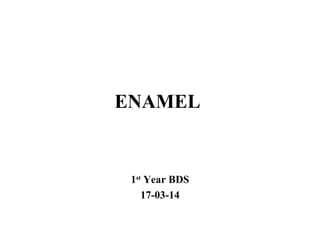Enamel 1 (Abdullah Akbar)
- 2. šÝšÝßĢ Preparation Practical: Roll # Group 1st Turn 2nd Turn 3rd Turn 1 - 10 A 3-Jan 4-Jan 3-Jun 11 - 20 B 1-Feb 2-Feb 4-Jun 21 - 30 C 3-Feb 4-Feb 5-Jun 31 - 40 D 1-Mar 2-Mar 1-Aug 41 - 50 E 3-Mar 4-Mar 2-Aug 51 - 60 F 5-Mar 2-Apr 3-Aug 61 - 70 G 3-Apr 4-Apr 4-Aug 71 - 80 H 1-May 2-May 1-Sep 81 - 90 I 3-May 4-May 2-Sep 91 - 100 J 1-Jun 2-Jun 3-Sep
- 5. Introduction Definition: The hardest mineralized tissue which covers the dentin in the crown portion of the tooth is called enamel. Physical & Chemical Properties ï§ Living or non-living ï§ Thickness 2-2.5 mm ï§ Brittleness ï§ Permeability ï§ Color ï§ Translucency ï§ Radio-opaque
- 6. Composition ï§ Inorganic content: 96% (Hydroxyappatite Crystal) ï§ Organic content: 4% (Enamal proteins & Water)
- 7. Enamel Protein ï§ Amelogenins: 90% ï§ Non-amelogenins: 10% Enamelin Ameloblastin (Amelin/Sheathlin) Tuftelin
- 8. Enamel Protein ï§ Non collagenous proteins ï§ Enzymes for degradation (Enamelysin & Kallikrein4 (KLK4) ï§ Noval secretory proteins (Amelotin & Apin)
- 9. Mano is my friend!!!!
- 10. Structure Enamel rods âĒ Fish scale appearance âĒ Key hole appearance Cross striations Striae of retzius Hunter-schreger bands Gnarled enamel DEJ Surface enamel âĒPerikymata âĒEnamel cuticle (Nasmythâs membrane)
- 11. Age Changes ï§ Tooth wear (Attrition, Abbrition & Erosion) ï§ Occlusal facets ï§ Discoloration ï§ Color ï§ Reduced permeability ï§ Composition of surface layer
- 12. Defects of Enamel 1. Organic defects 2. Developmental defects
- 13. Organic Defects Enamel spindles Enamel tufts Enamel lamellae
- 15. Developmental Defects A. Hereditary Disturbances in the Structure of Enamel * Amelogenesis imperfecta B. Acquired Disturbances in the Structure of Enamel * Focal enamel hypoplasia * Generalized enamel hypoplasia
- 16. Amelogenesis Imperfecta Stages of Development of Enamel 1. Enamel matrix formation 2. Calcification 3. Maturation Types of Amelogenesis Imperfecta 1. Hypoplastic type 2. Hypocalcified type 3. Hypomaturation type
- 19. Other developmental abnormalities Fluorosis Tetracycline stains
- 20. Clinical Considerations ï§ Cavity prep. ï§ Deep fissures ï§ Lamellae ï§ Fluoridation ï§ Acid-etching
- 21. Ends
- 22. End






















